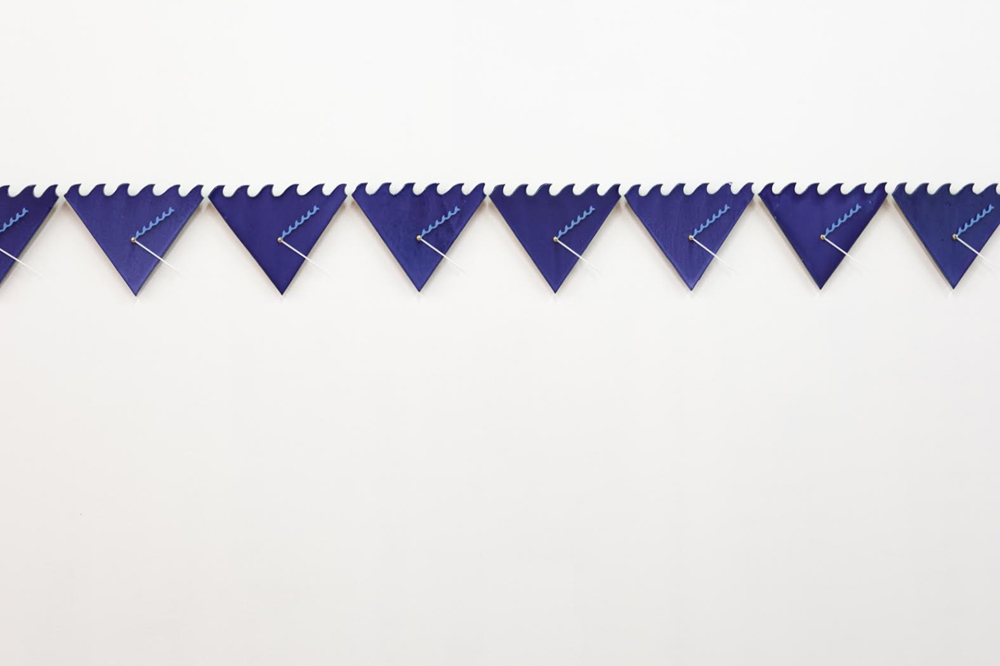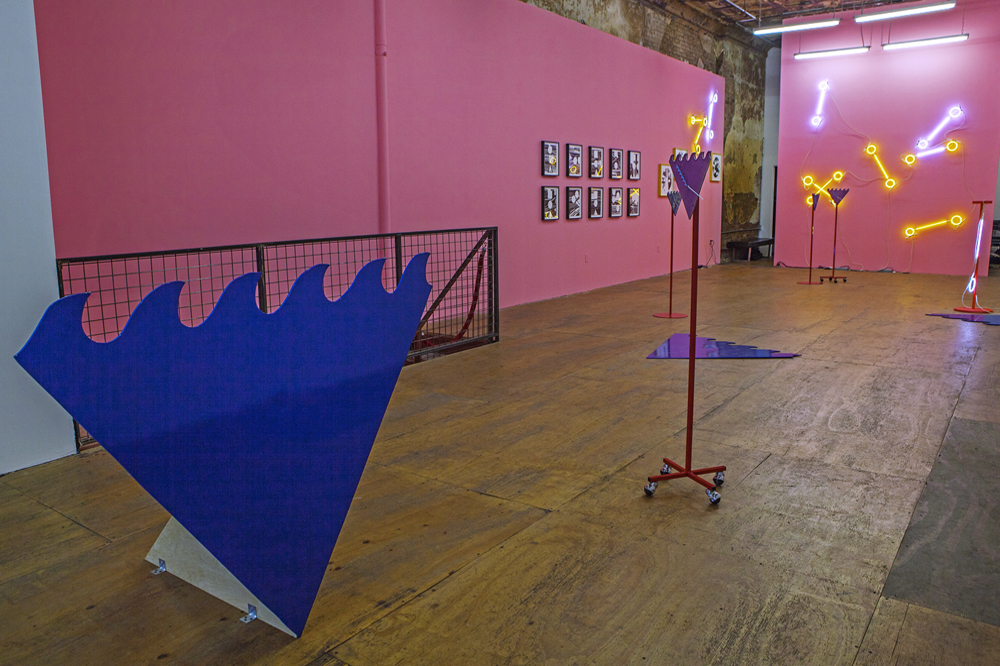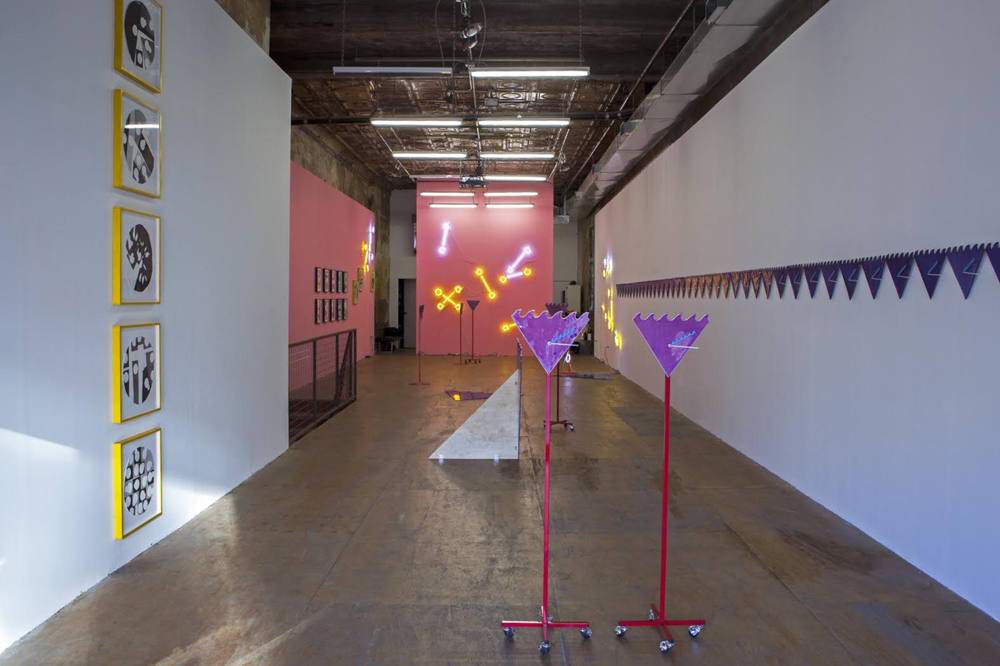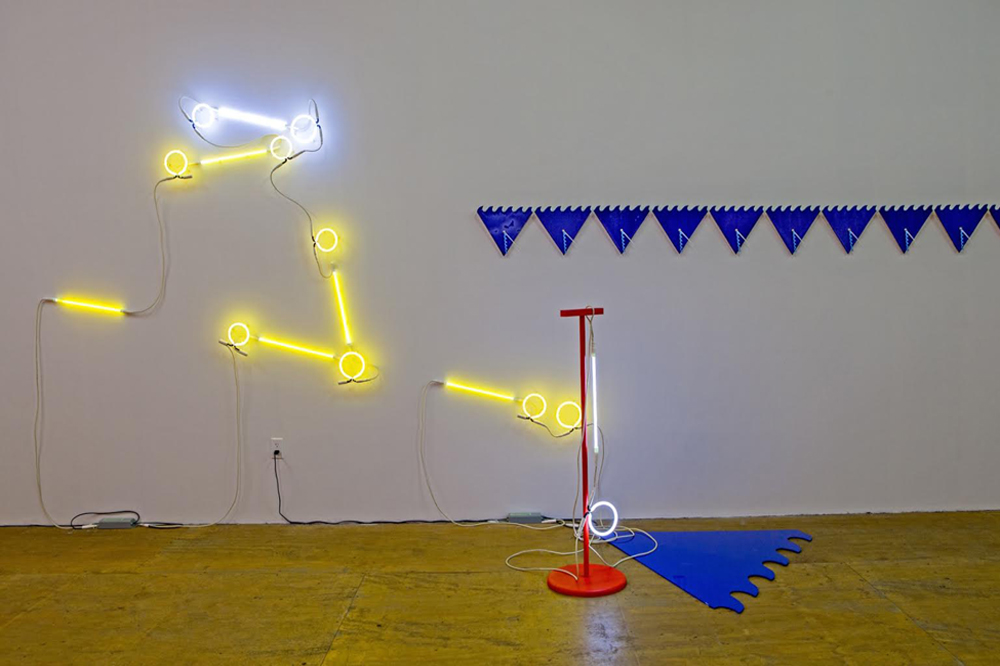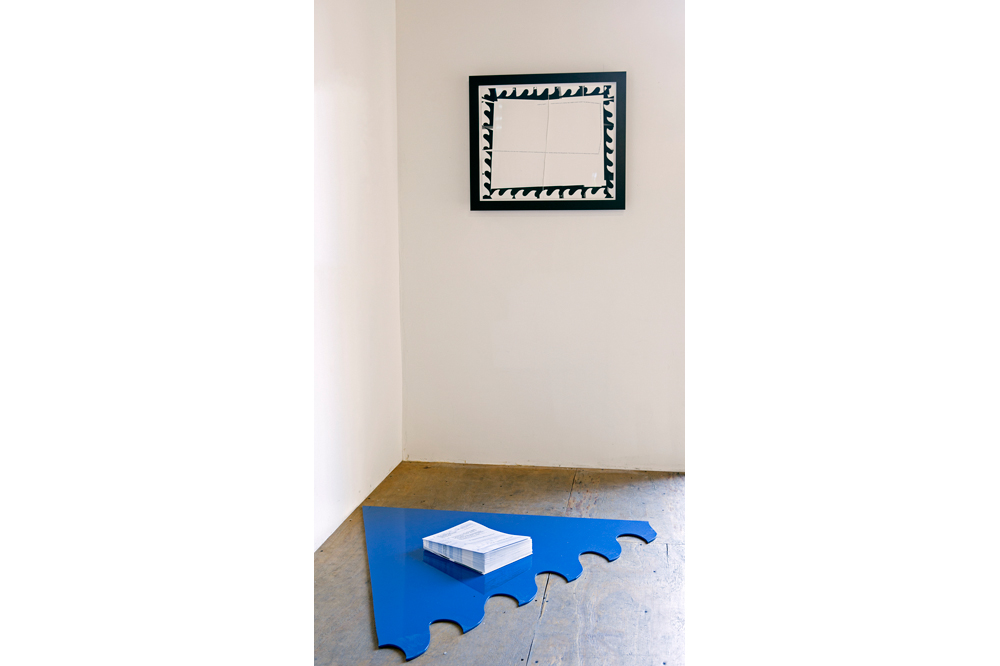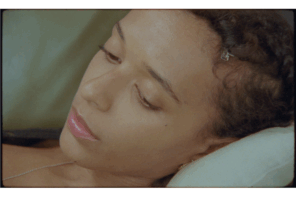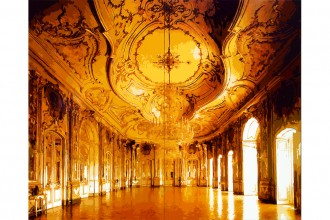“1. I believe in an alchemy of time. That a certain combination of words, a length of inaction, a discomposed room, or with some such cipher, I believe we can make time.”
So begins a numbered list of enigmatic, forceful phrases and paragraphs distributed seemingly at random on the surface of a large, decorated poster. Some entries are elliptical fragments (“Beyond the will to measure”), quotations by figures like Gertrude Stein or Jack Smith, or philosophical meditations on time and politics. They all constitute Uncounted, the text distributed at the solo show by Emily Roysdon titled If Only a Wave at New York’s Participant Inc. earlier this year.
The opening assertion of Uncounted showcases much of Roysdon’s poetics in its combination of declarative tone, humble description, and utopian premise – the fabrication of time. At Participant, a conglomeration of abstract shapes in pastels, fabricated clocks, and line segments made in neon suggested a personal cryptography. The wave-shaped clocks hung in a straight line on a wall alongside free-standing variants, the generous white and yellow light of the neon clashed against a pink wall, and a grid of black-and-white photograms (photographic images made without negatives) hung like scrapbooked riffs on Moholy-Nagy. When read alongside the free mass-produced text of Uncounted, the exhibition began to cohere but only to a point. If Only a Wave relied on a communication composed of a formal visual symbolism and a theoretical manifesto, with all the gaps in knowledge between the two. Or rather, these aesthetic elements “discomposed,” one of the many reoccurring mantric tropes Roysdon gathers on text and on the wall: “discompose,” “What is time if not activism?”, “unseen in time,” the wave, the clock, the line, and more behind the scenes: a queerness.
Roysdon could be called a “queer artist” by virtue of her personal affiliations and frequent subject matter, including a 2011 performance at The Kitchen where she imagined Susan Sontag’s biography exclusively within the confines of a gay bar. Roysdon also formed one quarter of LTTR (“Lesbians to the Rescue”), a queer-feminist publication and artistic collective consisting of Roysdon, K8 Hardy, Ulrike Müller, and Ginger Brooks Takahashi. But to brandish sexuality as the defining motif of Roysdon’s career would be to myopically downplay her interests in history, activism, choreography, and differing formats of artistic presentation. In 2010, she curated the well-received Ecstatic Resistance, a pair of group exhibitions that argued for political action as a concatenation of protest, desire, fantasy, and commitment. But the erotics of identification and affiliation always press on Roysdon’s historiographies and semiotics: some of the photograms in If Only a Wave, after all, were designed with the aid of a large butt plug.
MOMUS met with Roysdon in the days immediately preceding her exhibition’s closing component, a performance based on her text that involved similarly motivated artists like Sharon Hayes and Gregg Bordowitz. The following conversation may illuminate the more enigmatic notes in If Only a Wave, but ideally it serves as a further condensation of the show’s inquiries, a compatible gathering of the themes and questions that motivate Roysdon’s work.
I saw the exhibition at Participant as a composite of various motifs at play in your overall oeuvre – the wave, the inverted triangle, and the circle and the line segment. In one of the pieces in If Only a Wave called Calendar, I saw the same black-and-white collage-like technique as in your 2011 piece Positions. Has this geometry been a constant structure in your work?
The connecting point you could say is the question of time. Through most of the years, I’ve been thinking through different variations of the relationship of movement and image. I was thinking about time and different modes of performativity. The stuff in Positions is still representational. Making the calendars with the butt plug – using something that has a more urgent relationship to the body but that’s non-representational in order to talk about these other things, that’s the big difference for me. I think of these shapes as orbiting each other, but they don’t exactly click together. It’s not like one begets the other. The wave was really a question of surface, depth, and perceptibility.
You have that line in your text/poster: “If only a wave in proximity to other waves. If only a wave that made a texture of a surface of a top of the line. If only a wave expressing the contour of a bottom, its bottom, the under.” These are, in a sense, impossible things, because there’s no bottom to a wave and the top of a wave’s line is perpetually in flux. The wave only takes shape through movement.
I was really into this “uncounted” thing, which is the title of the piece, and I thought the wave was perfect for that. That shape came from a wall-sized sundial I made in Portland last year. It really was one of these “gestalt” sort of things for me. In my notebook, the wave shows up as one of the possibilities and then I sort of stuck with it for two years. It’s a symbol for another kind of time. A lot of the things that I can throw at it – the different questions in the text – can land there.
I was looking at your Piers photographs from 2010 and after spending so much time with these shapes at Participant, I then saw the photographs as formal compositions. The pilings out of the water became their own geometry. But then of course in that series you have this particularly queer and historicized site. That’s something I like about your work – you have two vernaculars that often seem distant from one other – a code-based system and a sexual politics.
I’ve surprised myself by the kind of abstraction that has been in my work a lot. That just became a tool for thinking, really – I didn’t aim for it. Again, with the show at Participant, I think it’s the way [all the elements] clicked together. I can write about this term in the text, “to discompose” through performativity and performance, and then also make abstract photograms. It’s like the movement of thinking. This show didn’t cite itself the way the Piers photos did. That was about unmarked, non-monumental historical spaces. But still there’s this thread that relates to the current project about how and what we remember, and asking where “movement” comes from. I say that with all of the word’s resonances – historical, social, aesthetic. That brings us more to the neon works. Again, they appear totally formal and abstract, but for me they’re diagrams.
I think of a “queer aesthetic” as conventionally emphasizing sensuality, affect, materiality – aspects of immediacy. Yours is more abstract. Even the poster isn’t the most scrutable text in the world.
I hear this about myself, but it’s just how it comes out.
Was LTTR oriented in the same way toward theory or abstraction?
LTTR would sometimes get accused of being too academic. People can get confused about what is academic or what is intellectual or philosophical inquiry. My work, text – these are questions I ask myself. I’ll admit it can be a little inscrutable (other people’s word). The writing is more about proximities, and there are a lot of gaps, which I find productive.
How can you have politics with such abstraction? I can’t shake the demand that they be compatible languages, which is not a good impulse. How legible should a sexual politics be?
I get called an activist, which is quite fascinating if you look at the show. It was quite formal. It almost looked polite if you didn’t know some of the work was made with a butt plug. I don’t know if having done LTTR becomes part of the bio that gets enacted. Maybe it’s more anecdotal or circumstantial, but it means that I carry that knowingly and publicly into making work like that. The collaborative parts of this, which were the performative parts, that to me is a sexual politics. It comes from that legacy, which is present.
Along the lines of performance, did you intend for the neon circle and line-segment forms to be dance patterns?
I think of it them as diagrams. They’re not like Laban notation or [instructions] to two-step. I was trying to think of what I meant by that term “discompose.” It was like Ecstatic Resistance – I was using the phrase a lot to myself and had to think, “What do I really mean by that?” I worked through the term by writing this text. I made these diagrams, which I did for Ecstatic Resistance too. I liked these gaps, 0 – 0, this question of a transition. It’s a movement and a pause. It becomes a diagram when they’re successive. It’s like the wave, but different: what is creating movement? What is affecting what? What touches us now, and what affects our politics now? What are all the things uncounted, or not perceived, or not honored? I liked these references for questions of the margin and marginality.
There’s a double-entendre kind of effect in your work: marginality is a political position and a typographic space. But there’s also a kind of pedagogy in this schematic. For example, I read the Hyperallergic review of your show by Alexis Clements. She said she wanted to be taught what was going on in the installation. She was faced with an iconography and had to make sense of it with the help of the text.
I think of it more as an invitation than pedagogy. One day I’d love to give the text to a person who has a more theatrical training and who would treat it like it’s a script. I love turning things over. I like to give these things out – that’s why I like to make the free posters. It’s even a question of distribution – where do people encounter these kinds of ideas? I don’t think of it as instructive, I think of it as a open question-asking. Hopefully that touches people in strange ways. This text is dedicated to my friend [the artist and curator] Ian White, and the first time I publicly asked these questions he was running the associated artists project at LUX, a space in London for moving-image-makers. I asked them a bunch of these questions, “What is time if not activism?” and it sort of made them mad.
Because the questions were so enigmatic? I think for most people activism shouldn’t be a riddle. In the interest of political code-breaking, then, can I ask what you meant by “Beyond the Will to Measure,” in your poster? These textual leitmotifs consistently appear.
“Beyond the Will to Measure” is this question of the “uncounted.” All my projects really start in language, they always have. It’s always like, if you ask the question differently, what do you get? That phrase seems to be this really compact group of words that I can’t really break apart myself. It relates to this question of time, history, and making meaning amongst your peers. I like this idea; it’s perhaps romantic, it’s perhaps political, but it’s a question of presence, maybe, this question of aliveness. If you’re actively alive you’re not judging, measuring, counting; you’re doing something, whatever it may be.
The shadow on this text is this institutional question: I was influenced by when and where I was writing this question, in three museum conferences about the intersection of performance, choreography, and art. Doing three of them in the same year made an impression on me, seeing the usual suspects and maybe being one of them. I felt like those questions I asked in those contexts needed to stay present. In a way, I didn’t want it to be overly institutionalized, but I was asking this question of authorizing “alive time” and the management of “liveness.”
In recent critical theory, a common strategy has been to opposite a linear notion of normative time. For example, you quote Elizabeth Freeman, and she calls this idea “chrononormativity”; José Esteban Muñoz called it “straight time.” But all the clocks in If Only Have a Wave have this insistence on linear time. There’s a pressure of time moving forward. How non-linear was time in your installation?
It’s more about simultaneity. The linearity, I would say, is more of a joke about realness. In order for me to feel like I can propose this overly-burdened gestalt symbol for this time, this question, this historicity, this uncounted thing, I also wanted there to be some sort of realness factor. I am measuring beyond the will to measure. There is a little tension there. I like this faux-usefulness.
I found it anxiety-inducing, though. I was also thinking about the temporality of “the tide,” which speaks to the wave motif. It’s linear, but it’s also contradictory in that a wave is both progressive – it goes out; and regressive – it comes back in.
I didn’t want the clocks to produce anxiety. In their repetitiveness, and the volume of them, it’s architectural. I wanted to create this line that’s just a little above your head and your eyes (I’m short and I hang low). There’s some anxiety there, and it is another kind of horizon line.
The horizon line being both a spatial and temporal setting. I think a theory of simultaneous temporalities is productive.
I guess it’s theoretical, but it’s also just lived experience, like when I was becoming queer, and looking for the things that touched me – they’re idiosyncratic. Queer people don’t have a canon, or maybe we’re building one, hopefully many different ones. I think it’s that kind of “looking.” Greer Lankton was the show before mine at Participant and people hadn’t seen that work in twenty years. That’s what I’m talking about: this shit is already there. I’ve never been interested in rebuilding the wheel. It’s happened, there are things, and they touch us when we learn about them. I like this idea that there are all of these lives that have been lived and they’re these fragments that can move forward in time. Although I say “uncounted,” the text starts with the line “poetry makes nothing happen.” It’s this luxurious non-productivity; it’s the best kind of lie. That’s also a relationship to straight time or non-linearity.
To that end, you write, “The most crucial and most queer thing I can say is that these thoughts are all about that which is unseen in time. All that exists and goes unnamed, uncounted, disregarded. In a queer life you use and misuse shards of time, search out references, create your own constellation and pull small threads forward.” You’re talking about the creativity of being queer.
In terms of temporality, you also have the motif on the moon, in the exhibition text. I started thinking about the moon as representing the alternative time of the lunar calendar. I couldn’t help but think of a naturopathic kind of feminism, especially with the triangle form in the exhibition as a yonic symbol.
Woah, I didn’t go there. I do make a joke here where it says, “Your period is a great name for time.” So I can’t say I didn’t go there totally, but I’m not like, “eco-dykey.”
Can I ask about the color-scheme for the installation? The commentator in Hyperallergic said the pink triangle reminded her of the ACT-UP triangle.
In making the work, I did ask for “ACT-UP Pink”… I developed a lot of this with Kristan Kennedy at the Portland Institute for Contemporary Art. She’s an exceptional curator. She sort of held up this funny mirror to me, which I hadn’t had with a curator before. We became quite close and worked together for two years and a made a lot of this work together. She could flash my vocabulary back to me, in a way. When I was asking for colors, I said I wanted a “perfect blue” and “ACT-UP pink,” and she was like, “WTF, man? What are you talking about?” The work needs a sense of a humor, especially with the way it appeared formal. It needed the color as a counterpoint.
Can you explain the photograms a bit, where you made images without a negative?
There are two series of photograms in the show. One is from the Discompose Series, the other is what I call the Calendars. Those are the ones that use the butt plugs. I used the butt plug under the enlarger lens as if it were a sundial.
This whole project actually started with me falling in love with this beautiful gold sundial necklace I saw in a museum in Prague. I loved its absolute nonsense time. This thing might tell you what part of the day or what season you’re in, and that measure of time is interesting: not “now into the seconds” but “is it evening?” I was thinking about these calendars and I was using the butt plug. You have this exposure to light, it creates a shadow, it looks like a light bulb, it’s non-representational, but it’s totally about the body.
The other series is more a reflection of the other materials in the show and of process. You see, for example, the clock hands. I designed them and had them laser-cut. So in the photograms they are to scale, one-to-one. It was really fun for me to do these graphic compositions: I was able to use a darkroom so I didn’t have a by-the-hour pressure. I was experimenting and luxuriating for a while. Every section of the composition is a separate exposure, so I had these different tools: the wave clock hand (the minute hand), the hour hand is a straight line, and there were felt circles, squares, and triangles. Those are three primary shapes. I had already highlighted in the exhibition the triangle with the clock and then I wanted to expand that to the primary shapes to think about this “discompose” thing. I was thinking a little about music and scores, so I took those elements and pushed them around in the dark. Each image is around twenty exposures. The thing I like about them, is that no matter how hard I try, I fuck up. I’ll have an idea, something to aim for, I’ll take it one step at a time, I’ll try to remember what I’ve done on the paper, but its invisible and you only see the evidence once it’s developed. For me it was this question of composition and discomposition.
To “compose” would be to arrange something, to “decompose” would be to remove that arrangement, but would “discomposing” be to arrange “wrongly”?
“Discompose” is more a question of frames. I can’t get over decompose as more a materiality and a “natural” process.
We were talking about a queer canon and queerness having to make its own history and you just mentioned “ACT-UP pink” and what I would call “Jarman blue.” I can’t help but sense that a queer canon now is already forming and it’s produced a kind of ossified melancholia. I was studying the 1995 Félix González-Torres exhibition at the Guggenheim, and he has become a sort of saintly figure. His work is almost always talked about in terms of reverence, mourning, and emotionalism. I’m thinking of your 2001-2007 series on David Wojnarowicz, who has assumed the dimensions of a tragic hero.
How important is amnesia, then? Is there a way to memorialize political history and inequity without fetishizing its emotional patterns? You have that quote, going back to the butt plug, in a 2004 LTTR essay called “Anus Rhymes with Famous”: “Reaching for the relationship between mastery and conflict, articulation and memory, exhaustion and identification. I want us to work – work the conflict between what is written and what is remembered. time and history. I write, want us to write to remember. tightly binding articulation to memory. practising, evaluating, repeating …”
I like that question of being allowed to forget. I think that’s the recess of the wave, or “beyond the will to measure”; “What is time if not activism?” I think that there’s an energetic compulsion to generate and redefine. I think that is happening and should be celebrated in the things that we do. I think that you’re right: now is this crossover moment. The distance to the AIDS crisis has become enough for another kind of reflection in the last few years and that might interconnect and be part of what you’re seeing as an emergence of the canon. [This is also happening] for the feminist art movement. Both of those things are on different timelines, yes, but in terms of the reflective distance, they both seem to be pointing to those things being canonized. What we always know – which is why I think those of us that identify identify – is that those boundaries are policed and need to be exploded. That’s why I’m interested in the things that have been unseen in their own time.
It’s funny that you mention Wojnarowicz because he appears that way now, but in his living days, his experience was something else entirely. And then we have Judy Chicago – that’s the question of representation, how people get pulled out of groups and become icons. I went to graduate school as a student of Mary Kelly and doing LTTR got that other generation of women to call us, sometimes, and be like, “What’s up?” We got to meet people and have conversations and I was looking at their generation and seeing how people have different coping mechanisms with where they’ve landed in histories, museums, and in critical conversation. The only reason that I do what I do now and let myself do what I do, is having grown up inside of LTTR.
I used to have what I called a “use-value issue.” I used to think that I had to be useful and work for the UN or something, instead of making butt-plug photograms. But being in LTTR and working collectively for so many years gave me a context that I think was productive enough for me to release the idea of usefulness.

